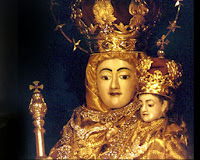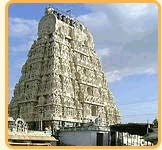
VAILANKANNI where the Shrine Basilica of Our Lady of Good Health gloriously stands, is situated on the East Coast 10 kms to the south of Nagapattinam which is 350 kms to the South of Chennai the Capital of TamilNadu, India.
The history behind the global fame of Our Lady of Good Health, is founded on three events that took place intermittently since the 16th Century at Vailankanni. The foremost incident is the Apparition of Our Lady, Mother of Jesus, which occurred during the pleasant daybreak on a sunny day in the 16th century, when a shepherd boy, carrying milk was on his way as was his daily practice, from Vailankanni to his master at Nagapattinam. Despite the morning freshness, fatigue overcame the little dutiful boy as he was passing by a water pond at the Anna pillai street at Vailankanni. Placing the milk-pot near the banyan tree by the water pond, the boy fell into an unusual slumber, only to be startled to his feet by the sweet vision of a most graceful Lady of exquisite beauty, holding in her hand a most charming child of divine appearance. Both wore celestial halos around their heads. As the boy was still in a world of surprise, shock and happiness the Lady asked of him some milk for her child. Filled with reverence and awe, the boy offered milk. The heavenly smile of the Child and Mother was the only message. The impatient master did not believe the narration of the boy. But to the greater astonishment of all present, the milk began to surge over the pot and flow out. On reaching the place of apparition, the gentleman and others began to believe in the heavenly Lady. This place began to be called, "Our Lady's Tank". Around the end of the 16th century, there lived at Vailankanni a poor widow with her son who was lame by birth. Every day the lame boy used to sit under a banyan tree at a place called 'Nadu Thittu' (central mound) and sell butter-milk to the thirsty wayfarers. On a certain day, to his bewilderment, a very bright light appeared in front of him and from amidst the light, a Lady of peerless grace with a divine Child in her arms, asked the boy for a cup of butter-milk. Then She directed him to go and inform a catholic gentleman at Nagapattinam to put up a Chapel in her name on the spot of her apparition. The boy realised that his lame legs have become normal upon the word from the Lady. With great joy, he buoyantly ran to Nagapattinam to carry out the errand. Having been already directed in vision by Our Lady, the Catholic gentleman, with the support of the people, built a Chapel at 'Nadu Thittu' where now stands the present Shrine Basilica. The Lady was called, 'Our Lady of Good Health'.
In the 17th century, a Portuguese merchant vessel, sailing from Macao in China to Colombo in Ceylon was caught in a tempest in the Bay of Bengal.The helpless sailors besought Mary the Star of the Sea to save them.
They vowed to build a Church in her name, wherever they could land on. The stormy sea became calm. Their ship landed near the
Historical Data of Vailankanni Shrine
The history of Our Lady of Good Health, Vailankanni, dawned in the 16th century
In September 1771, Vailankanni which had been a substation of Nagapattinam Parish, was raised to the status of a Parish.
The majestic Shrine facing the East, was renovated twice in 1920 and 1933.
His Holiness Pope John the XXIII, raised the Shrine to the status of 'Basilica' on
The storeyed extension Basilica was blessed and opened in 1975.
In 1985,the little Chapel at Our Lady's Tank, was built a new and blessed.


